Nowadays, people look at a brand not only to see the value of the brand itself, but to understand the cultural value conveyed behind the brand and experience the connotation of the brand culture. Human-computer interaction technology has also gained more application space with the development of the times. Therefore, a psychological model of brand culture based on human-computer interaction was designed in this paper, and a survey of related content was conducted. In terms of user satisfaction survey, it was concluded that the use of the brand culture mental model based on human-computer interaction technology could greatly improve users’ satisfaction with brand culture and make more people love brand culture; in terms of user participation survey, it was concluded that the brand culture mental model designed based on human-computer interaction technology could achieve better profit results at 21:00 on Sunday. Finally, a survey of user stickiness was carried out, and the test results showed that the brand culture mental model based on human-computer interaction technology established the stickiness between users and brands.
A series of visual art works such as painting, photography, sculpture, architecture, calligraphy, etc. can all show certain aesthetic functions. In visual art, form is mainly the external form that conveys the artistic image. The most essential feature of art lies in its own special form, which is the carrier of art and the life of a work of art. In visual art, the form of expression includes size, shape and combination, etc. The form must be attached to an internal structure before it can be intuitively reflected. Form does not simply refer to the shape of an object, but expresses a visual stance, which is the main factor causing aesthetic feeling. The formal beauty of visual art is a kind of rational cognition of the formal laws of natural objects produced by people in production and life. The internal form of visual art emphasizes the mutual combination of color, texture, shape, space, etc., which needs to be displayed through organizational structure and artistic language. For visual art designers, it is necessary to master the laws of form beauty and use them flexibly in the design process, so that people can discover beauty in form and generate associations and perceptions.
The most important way for people to understand brand culture is through advertising. People learn about a brand from the images they see and the language descriptions they hear. However, in the process of brand transmission of culture, it is inevitable that pictures would be distorted or language descriptions would be exaggerated, which would create a gap between users and brands. Users often feel that they have been deceived and that the brand culture they receive is false information. As a result, the brand would decline, and the company would suffer a major blow, not to mention the spread of brand culture.
Human-computer interaction technology realizes the dialogue between people and computers. At present, human-computer interaction technology is booming, and human-computer interaction technology is used in all aspects of life. Such as product demonstration, design, assembly, ergonomics and performance evaluation in the industrial production process; immersive virtual world system (3D projection technology) in the education industry; biometric identification technology in life and virtual reality interaction technology in the medical field: virtual surgery training, remote consultation, surgery planning and navigation, remote collaborative surgery, etc. The use of these human-computer interaction technologies has greatly improved people’s quality of life and made people more eager for a better life. Therefore, human-computer interaction technology can be used to design a mental model of brand culture, so that brand culture can be more deeply rooted in the hearts of the people. It can also make users and brands sticky, thereby promoting the spread and development of brand culture.
Brand culture has attracted the attention of many scholars, and many scholars were devoted to the study of brand culture. Halkias G drew on international brand literature and schema incongruity research,
Halkias G assessed the effectiveness of international brand communication by juxtaposing three alternative advertising modalities based on local, other national and global consumer cultural imagery;
Halkias G studied the internal mechanisms of consumer responses to international brand communication.
The results of the analysis showed that when the global advertising image was meaningfully associated with other national brands, the perception of credibility increased and had a positive effect on advertising attitudes [1]. Gvili and Levy [2] examined the key role of online shopper culture (collectivism vs individualism) and past experiences as drivers of engagement in brand-related information sharing. A conceptual framework was established and empirically tested based on Theory of Planned Behavior (TPB) and Consumer Culture Theory (CCT). The showed that shopper experience was indirectly related to brand-related information sharing and was mediated by three TPB beliefs (attitudinal, subjective norm, and perceived behavioral control). These relationships were mediated by customer culture, the impact of attitude on information sharing was greater for collectivist shoppers, while subjective norm was greater for individualistic shoppers.
Hollebeek and Belk [3] outlined two ways that consumer technology promoted brand engagement and its impact on well-being, addressing well-being issues related to consumer technology promoting brand engagement from a sociological, anthropological, and cultural perspective. Jakubanecs et al. [4] demonstrated the impact of using free association techniques on brand affective and functional associations in Western and East Asian cultures, as well as identifying and testing underlying mechanisms. The study showed that the inspiration context significantly affected the brand emotion type and functional association in two different cultures (Norway and Thailand), and consumers’ self-interpretation and thinking style played a mediating role in the cultural effect. Kowalczyk and Kucharska [5] proposed a model to examine the impact of stakeholder pressure, culture, and corporate social responsibility practices on company brand performance, reputation, and employee identification. The results of the study showed that the relationship structure of project-managed construction companies varies in developed countries such as Germany and in rapidly transitioning Poland. Kitirattarkarn et al. [6] expanded on the different types of brand-related user-generated content created by different sources by explicitly examining how collectivism-individualism dimensions at the national and individual levels affect consumer engagement (likes, comments, and shares). Liu [7] conducted a qualitative study of the anniversary celebrations of Chinese department stores, and showed that the focus events are still successful. Because its well-managed coordination of on-stage and back-office activities helped reproduce an employee culture that embraces and voluntarily develops company-mandated role norms, values, and beliefs. For consumers and businesses, a brand is not just a brand, but a tool for people to spread and receive culture. Based on this, researchers are not simply pursuing the brand, but put their goals on a deeper cultural connotation. Due to the development of technology, researchers are committed to combining brand culture with advanced technology to achieve a more profound cultural communication effect.
Human-computer interaction is a popular technology in the information age, and many scholars have studied it deeply. Rautaray and Agrawal [8] reviewed state-of-the-art vision-based gesture recognition methods from different stages of the gesture recognition process and analyzed the advantages and disadvantages of these various methods in detail. Han et al. [9] begun by summarizing the history of the foundations, achievements and collaborations of the Human-Computer Interaction Laboratory over the past 10 years and described the current research directions related to information visualization. Finally, the facilities and equipment were introduced to fully support the research work [10]. Wei et al. [11] focused on situational awareness in intelligent human-computer interaction with the aim of providing a platform for situational awareness in intelligent human-computer interaction for time-critical decision making. Pan et al. [12] explored the research frontiers of intelligent user interfaces, with a particular focus on personality modeling, which examined how computational models of personality affect intelligent users. Mori and Kelkar [13] mainly focused on the evolution of human-computer interaction and studied the topic of human-computer interaction (HCI), which explored the relationship between humans and computers. Le et al. [14] used human-computer interaction technology for deep learning, which provided a new solution for deep learning. Hernandez et al. [15] proposed a seamless Human-Machine Interaction (HCMI) architecture to support the supervisory activities of operators in flexible manufacturing systems.
In order to let more consumers understand the brand culture and be interested in the brand culture of the company, this paper designed a mental model of brand culture based on human-computer interaction, and conducted the evaluation of the mental model in five aspects: user pleasure, participation, acceptance, retention rate, and task completion rate. The design of the mental model based on human-computer interaction brand culture aimed to make the brand culture deeply rooted in the hearts of the people and maintain a standing position in the hearts of the masses.
This paper proposed an algorithm for the mental model of brand
culture based on human-computer interaction technology. The
establishment of a brand culture mental model matrix can effectively
sort and undertake the feedback data and the generated data. The design
of the brand culture mental model matrix needs to establish a membership
function [16]. When
considering human interaction technology, it is necessary to limit the
threshold value to be limited as:
In Eq.
When limiting the input/output conditions of the model, it is
expressed by Eq.
In Eq.
After the conditions of Eq.
In addition to establishing a mental model of brand culture, data
execution capabilities and feedback capabilities also need to be revised
[17]. The revision process
first needs to limit the use of the data environment. The process is as:
After the conditions are limited, the level mapping calculation is
brought into the established human-computer interaction industrial
product model matrix, and the level mapping is completed. The process is
as:
Based on the function approximation performance of neural network,
under the optimal approximation of neural network, the mental model of
brand culture can be written as:
Among them,
The radial basis function matrix
On compact set
Then the neural network approximation of
The design of the brand’s cultural mental model is based on vision. The perception characteristics of vision on the cognitive process of object size, depth and relative distance, brightness and color, etc., are helpful for interface design. The factors that affect the mental model of brand culture by vision are recorded in Figure 1.

The size, depth and relative distance of vision, brightness and color would all have a certain impact on the mental model of brand culture [17, 18].
Visual size: the eyes perceive the length of the object, the area and volume of the object differently, and the visual effect presented is also different, and the size of the object itself would also affect the user’s visual experience. Under the condition of the same distance, the larger the object, the larger the image would appear on the retina; the smaller the object, the smaller the image would appear on the retina. Users would have a psychological expectation on the size of the brand culture page, so special attention should be paid to the visual design and the reasonable arrangement of the size of the objects.
Depth of vision: The depth of binocular vision can clearly perceive the 3-dimensional world because a pair of eyes can form parallax for the same target. Therefore, it is necessary to use binocular vision as the machine’s vision system to perceive the 3D world during interaction.
The relative distance of vision: The distance that people perceive the object is different, and the image of the object on the human eyeball is also different. For the same object, the closer the relative distance, the larger the image of the object; the farther the relative distance, the smaller the image of the object.
Brightness of vision: Light would affect people’s visual judgment. People would have dark adaptation when they go to the dark place, and light adaptation would occur when people feel the light in the dark environment. Since people have different adaptations to light perception, this principle is also used in daily life. For example, smartphones can automatically adjust the brightness according to the intensity of ambient light to debug the brightness suitable for human eyes. Also, if the light is too bright and too dark, the eyes are constantly in a state of overregulation, which can also cause eye strain. Over time, it can lead to vision loss. Therefore, in the design of the mental model of brand culture based on human-computer interaction, it is necessary to avoid light that is too bright, too dark, and unstable.
Visual color: The meaning of different colors seen by the human eye lies in the existence of color temperature of different colors, which in turn affects people’s psychological feelings. This makes use of the principle that different shades of color give people different psychological feelings. Therefore, in the design of the psychological model of brand culture based on human-computer interaction, it is necessary to make good use of color tones to create different emotional atmospheres for people.
The user understands the brand culture not only to understand the brand culture itself, but also has new demands for the brand culture. The user desires the brand culture to be related to themselves. Therefore, the ultimate purpose of the design of the brand culture mental model is to meet the user’s psychological expectations for the brand culture [19]. The operational model expresses the technical principle, while the mental model expresses the user’s cognition. Only through the expressive model can a bridge be built between the two. The closer the phenotype is to the mental model, the more users can accept the brand culture, and the brand culture can be accepted by the majority of users. The relationship between the three is shown in Figure 2.

Based on the above principles, this paper aims to make the performance model of brand culture close to the user’s mental model. The mental model of brand culture must also be developed around the perspective of user psychology, so that it can be analyzed according to the different psychological modes of users [20]. Based on human-computer interaction technology, the design of the brand’s cultural mental model should include both people and machines, which together constitute a large collective of the environment. The specific design is shown in Figure 3.
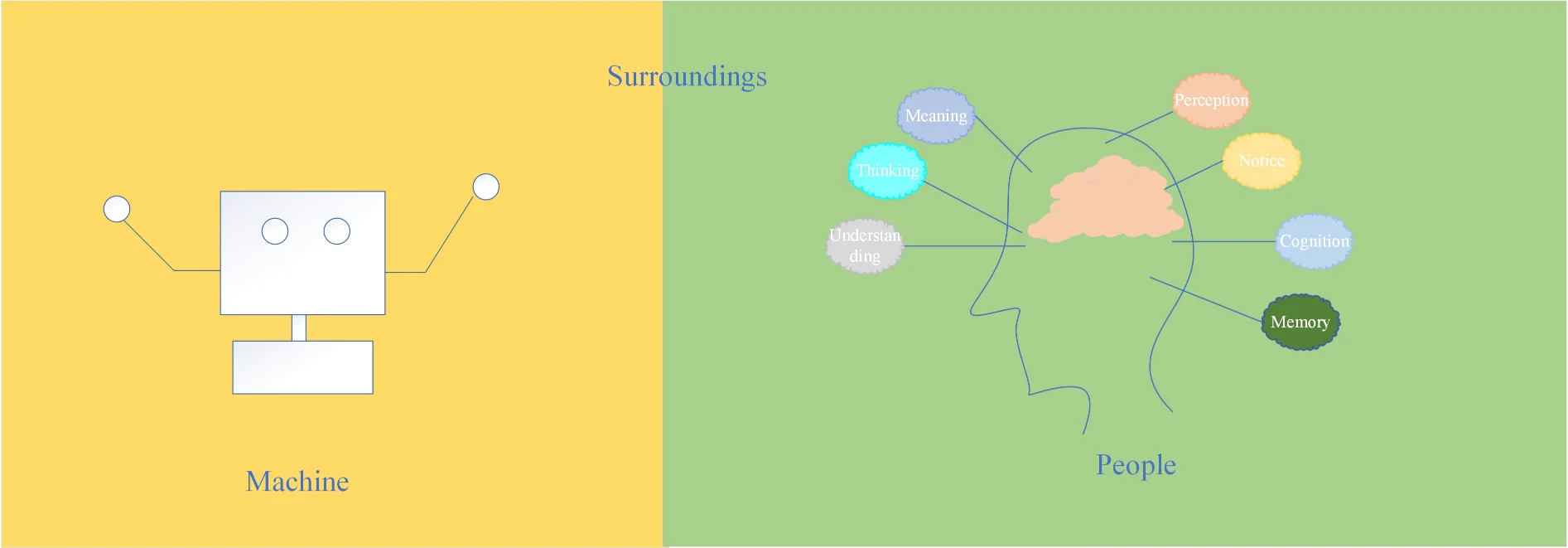
The design of the mental model of brand culture based on human-computer interaction technology integrates machines and people. Machines, as the name suggests, are electronic devices such as computers and mobile phones that people use in daily life, while the human level mainly uses people’s thinking abilities, such as feeling, perception, memory, understanding and other abilities.
Because the fundamental purpose of designing brand culture mental model based on human-computer interaction technology in this paper is to satisfy people’s psychological expectations for brand culture and to satisfy people’s psychological pleasure. This paper designed a mental model of brand culture based on human-computer interaction technology and put it into use. The ease of use, usability and visual aesthetics of the brand culture mental model were compared with those of the traditional brand culture mental model to test whether the brand cultural mental model can achieve the expected effect and whether it can meet the needs of large-scale use in the market. The test results are recorded in Table 1 and Figure 4.
| Culture Mental Model Based on Human-computer Interaction |
Traditional Brand Mental Model of Brand Culture |
|
|---|---|---|
| Usability% | 59.4 | 68.6 |
| Availability% | 61.7 | 65.9 |
| Visual Aesthetics% | 68.4 | 79.5 |
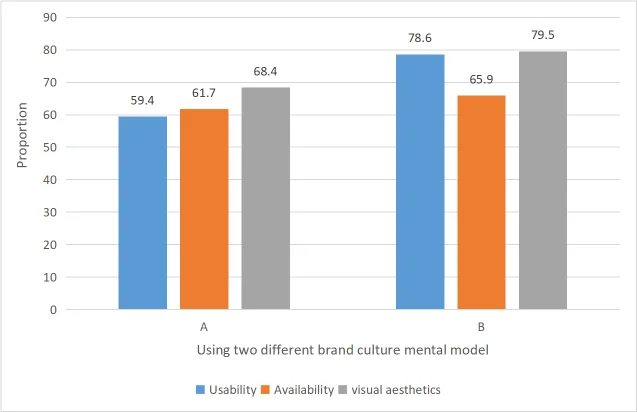
According to Table 1 and Figure 4, the psychological model of brand culture designed based on human-computer interaction technology had improved ease of use, usability, and visual aesthetics compared with the traditional psychological model of brand culture. Among them, ease of use increased by 19.2%, the fastest improvement, visual aesthetics increased by 11.1%, usability increased by 4.2%, and the slowest improvement.
In addition to the user’s satisfaction survey on the brand culture, the user’s participation in the brand culture is also a very important evaluation indicator. User engagement can be characterized by data such as the number of active users, the number of user clicks, and the per capita usage time. This paper recorded the data of users’ participation at different times, and compared the psychological model of brand culture designed based on human-computer interaction technology with the traditional psychological model of brand culture. The survey results of the number of active users in different time periods are recorded in Figure 5.
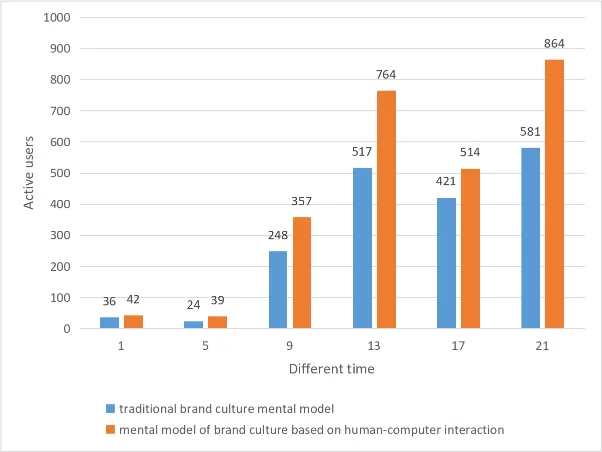
It can be seen from Figure 5 that users had different activity levels in different time periods, but the number of active users in the psychological model of brand culture designed based on human-computer interaction technology in each time period was more than that of the traditional psychological model of brand culture. This showed that the psychological model of brand culture designed based on human-computer interaction technology solved the pain points in people’s hearts, and people were more willing to use the psychological model of brand culture designed based on human-computer interaction technology. 13:00 and 21:00 were two peaks of high active users, so it was necessary to make good use of these two peaks to push high-quality brand culture to users, so as to maximize brand benefits.
The number of clicks of users using two different brand culture mental models in different time periods is recorded in Figure 6.

It can be seen from Figure 6 that there was a large difference in the number of clicks of users in different time periods, and the general trend was roughly the same as the number of active users in different time periods. However, the number of user clicks of the brand culture mental model designed based on human-computer interaction technology in each time period was more than that of the traditional brand culture mental model. Among them, the number of user clicks on the psychological model of brand culture designed based on human-computer interaction technology at 21:00 was more than double that of the traditional psychological model of brand culture. The reason was because most users were most relaxed in the evening after a busy day, and their psychological defenses were not as strong as usual. If the brand culture was used to impact users during this time period, the user was very likely to have a deeper impression of the brand, which would affect the user’s consumption behavior, and the user would be more inclined to buy branded products.
The per capita usage time of users who use the brand culture mental model designed based on human-computer interaction technology and the traditional brand culture mental model in one week is recorded in Figure [f7].
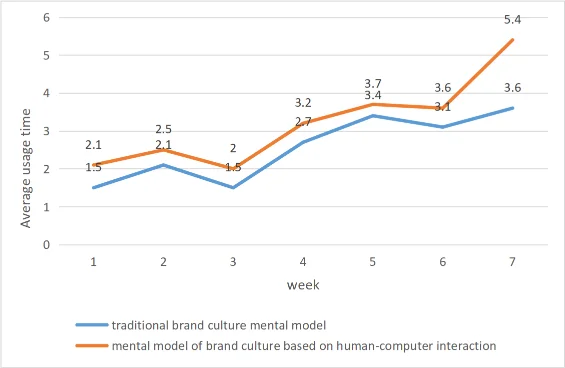
It can be seen from Figure 7 that within a week, users had different tendencies to use the mental model of brand culture designed based on human-computer interaction technology. Among them, users used the brand culture mental model based on human-computer interaction technology for the longest time on Sunday, which showed that users were more likely to accept brand culture on Sunday. Therefore, in terms of the psychological model design of brand culture, it was necessary to strengthen its delivery work on Sunday to strengthen the stickiness between users and the brand, and at the same time, more target customers should understand the brand culture, so as to achieve the purpose of the brand being deeply rooted in the hearts of the people. It is combined Figures [f5], [f6], and [f7], it can be seen that putting the brand culture mental model based on human-computer interaction technology at 21:00 on Sunday could achieve better profit effects. Therefore, the design of the psychological model of brand culture based on human-computer interaction technology should increase the delivery mechanism, so that more people can understand the brand culture [21].
The indicators of user pleasure, engagement, acceptance, retention rate, and task completion rate are all based on 60%. The traditional psychological model of brand culture is recorded as A, and the psychological model of brand culture based on human-computer interaction technology is recorded as B, and the survey results of various indicators are recorded in Figure 8.
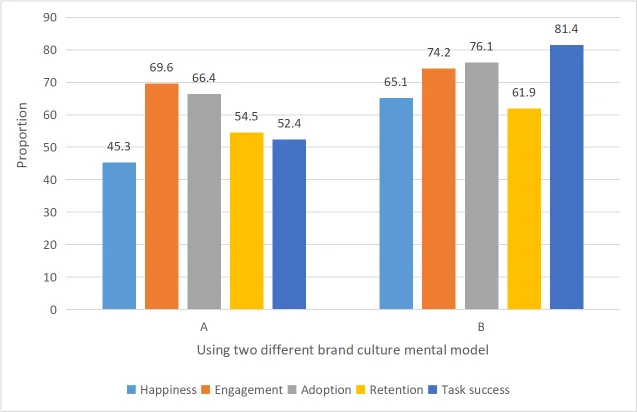
It can be seen from Figure 8 that the traditional brand culture mental model had not reached the standard in terms of user pleasure, retention rate and task completion rate. However, the brand culture mental model based on human-computer interaction technology could basically satisfy the user’s pleasure, participation, acceptance, retention rate and task completion rate, and it had the best performance in task completion rate, users could well complete the tasks sent by the brand, which reflected that the brand culture psychological model based on human-computer interaction technology had established the stickiness between users and brands.
The article designed a brand culture psychological model under the artistic visual performance using human-computer interaction technology, and conducted a user satisfaction survey on it. In terms of user satisfaction survey, it was concluded that the use of the brand culture mental model based on human-computer interaction technology could greatly improve users’ satisfaction with brand culture and make more people love brand culture. In terms of user participation survey, it was divided into three modules: in terms of user activity survey in different time periods, it was concluded that 13:00 and 21:00 were two peaks of active users; in the survey of user clicks in different time periods, it was concluded that the brand culture mental model designed based on human-computer interaction technology has the largest number of user clicks at 21:00; in terms of the per capita usage time of users who use the psychological model of brand culture designed based on human-computer interaction technology and the traditional psychological model of brand culture within a week, it was concluded that users used the mental model of brand culture based on human-computer interaction technology for the longest time on Sunday. From this, it was concluded that putting the brand culture mental model based on human-computer interaction technology design at 21:00 on Sunday could achieve better benefits. Finally, a survey of user stickiness was carried out, and the test results showed that the brand culture mental model based on human-computer interaction technology established the stickiness between users and brands.
This article is not supported by funds.
The author declares no conflict of interests.
1970-2025 CP (Manitoba, Canada) unless otherwise stated.